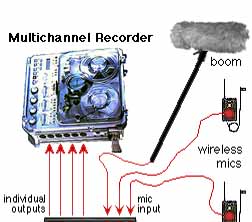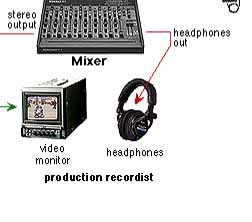|
Production of a Motion Picture
(page 3)
|
|

|
the video crew
The filming process means that you have to wait at least half
a day before you can visualize what has been shot. That time is necessary
for the film to reach the nearest lab, that this negative be developped and that
a positive copy be printed from it (only the good takes, indicated by the
script girl on the continuity report, of which
the lab gets a carbon copy).
Hence, in a tradition that goes back to the early days of movie making, the producer,
the director, the director of photography and sometimes the production recordist
(when the projection is done with sync sound) gather each night,
after the day's shooting, either at the lab, or the closest theater, to view
the dailies (name given to the shots in their raw form) of
the previous day !!!
In those days, it is only then that the people responsible of the film were aware
of what the camera operator had done at the time of the shooting ! It might not be
too late to reshoot a scene the next morning, when the filming crew hasn't moves
to another set yet. But all this isn't very flexible.
As soon as it was possible, the idea of a video surveillance of the frame,
live during the shooting, made its' way. The crew responsible for that equipment
is now an almost absolute must, for several reasons that deserve some explanation.
First, let's see how a video viewfinder works.
| The image coming through the lens is optically sent to the eyepiece
of the camera operator. Originally an optional accessory, now integrated in modern
cameras, the video output works with a prism separating the image in two, so that
the eyepiece still gets its' share. The other half hits CCD captors, such as the
ones found in modern video cameras, as to create a standard composite video signal
(PAL or NTSC, as needed). A BNC connector outputs the signal
which can then be fed to a video monitor, or, better yet, a video tape recorder (VTR). |
|
video viewfinder system
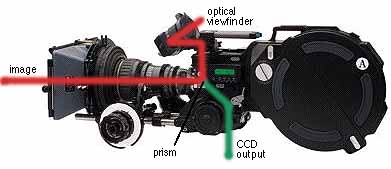
|
|
The video crew makes sure that the video monitors are calibrated to
display exactly the same portion of the frame that will be printed on the negative
film. With black gaffer tape (the typical scotch tape used by the audiovisual
industry) they'll mask the excess image on the picture tube.
The video viewfinder is at first used only as additional comfort during the
shooting, enabling the director to visualize the frame composition live, when before
he had to wait for the dailies the next evening. This new work method hasn't eliminated
the need for the traditional dailies projection : scratches may have occured
on the film because of a defect in the magazine, or the motor of the camera may have
gone nuts during the take. These problems cannot be detected any other way.
Then came the idea of recording the video output with a video tape recorder
(VTR), enabling the director to review a shot immediatly
after it has been completed. Since a VTR is capable of recording and reading audio
as well as video, the production recordist can also send a decent quality
stereo mix to the video crew, who will therefore be able to offer the director
to review the picture and sound of a shot !
The signal flow of a shootong will look like this :
And that's not the only advantage of the video
crew, it plays a much bigger role in modern day film production. Now that they're
here, the editing can take place almost simoultaneously to the shooting
! In order to do so, ideally, you would need time-code to be sent to the camera, the VTR and
the multichannel recorder (even though there are ways to go without, which
get quite complicated !).
| There are two options : A time code generator can distribute the time
code signal to every machine (fig. 1), or the audio
recorder (being the first machine to run when shooting) can
send it to the other machines (and itself) (fig. 2). |
|
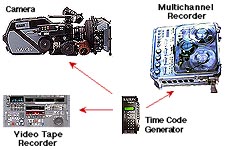
|
|
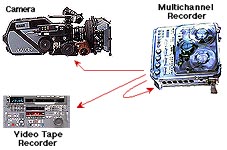
|
|
figure 1
|
|
figure 2
|
|
Whichever option is chosen, the point is to get the same time code adresses
on the full quality picture (camera negative), the full quality
sound (multichannel tape) and the low resolution version of
the picture and sound combined (video tape).
